| Fort Santiago | |
|---|---|
| Moóg ng Santiago | |
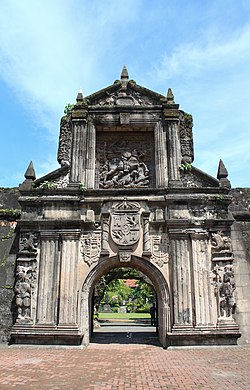 The reconstructed main gate of Fort Santiago The reconstructed main gate of Fort Santiago | |
 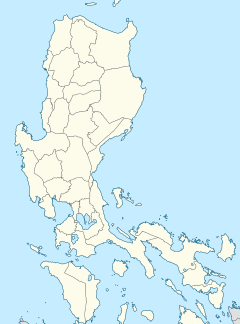  | |
| General information | |
| Type | Bastioned fort |
| Architectural style | Italian-Spanish school of fortification |
| Location | along the Pasig River |
| Town or city | Intramuros |
| Country | Philippines |
| Coordinates | 14°35′42″N 120°58′10″E / 14.59500°N 120.96944°E / 14.59500; 120.96944 |
| Named for | Saint James the Great |
| Construction started | 1590 |
| Completed | 1593 |
| Renovated | 1733 |
| Dimensions | |
| Other dimensions | 2,030 feet (620 m) perimeter |
| Technical details | |
| Structural system | Masonry |
| Design and construction | |
| Architect(s) | Gómez Pérez Dasmariñas (1590) Fernándo Valdés y Tamon (1730s) |
| Structural engineer | Leonardo Iturriano |
| Designations | National Historical Landmark |
| Website | |
| visitfortsantiago | |
Fort Santiago (Spanish: Fuerte de Santiago; Filipino: Moóg ng Santiago), built in 1571, is a citadel or castle built by Spanish navigator and governor Miguel López de Legazpi for the newly established city of Manila in the Philippines. The defense fortress is located in Intramuros, the walled city of Manila.
The fort is one of the most important historical sites in Manila. Several people died in its prisons during the Spanish Empire and World War II. José Rizal, the Philippine national hero, was imprisoned here before his execution in 1896. The Rizal Shrine museum displays memorabilia of the hero in their collection and the fort features, embedded onto the ground in bronze, his footsteps representing his final walk from his cell to the location of the actual execution.
It is only a few meters away from the Manila Cathedral and the Palacio del Gobernador (lit. Governor's Palace, currently the office of the Commission on Elections).
Profile
Adornments of the gate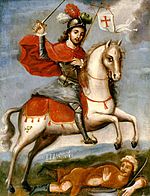 Image of Saint James (Santiago)
Image of Saint James (Santiago) The lesser arms of the monarch of Spain
The lesser arms of the monarch of Spain
The fort was named after Saint James (Santiago in Spanish), the patron saint of Spain, who is also known as Saint James the Muslim-slayer because of the legend that he miraculously appeared hundreds of years after his death to fight in the battle of Clavijo, whose relief adorns the façade of the front gate. It is located at the mouth of the Pasig River and served as the premier defense fortress of the Spanish Government during their rule of the country. It became a main fort for the spice trade to the Americas and Europe for 333 years. The Manila Galleon trade to Acapulco, Mexico began from the Fuerte de Santiago.
The fort has a perimeter of 2,030 feet (620 m), and it is of a nearly triangular form. The south front, which looks toward the city, is a curtain with a terreplein, flanked by two demi-bastions - the Bastion of San Fernando, on the riverside, and the Bastion of San Miguel, by the bayside. A moat connected with the river separates the fort from the city. Near the beginning of the north face, instead of a bastion, a cavalier called Santa Barbara was built with three faces of batteries, one looking seaward over the anchorage place, one facing the entrance, and the third looking upon the river. The latter is united with a tower of the same height as the walls, through which there is a descent to the water battery placed upon a semicircular platform, thus completing the triangular form of the fort.
The 22-foot (6.7 m) high walls, with a thickness of 8 feet (2.4 m) are pierced for the necessary communications. The front gateway façade measures 40 feet (12 m) high being in the south wall and facing the city. The communication with the river and the sea was by an obscure postern gate - the Postigo de la Nuestra Señora del Soledad (Postern of Our Lady of Solitude). Inside the fort were guard stations, together with the barracks of the troops of the garrison and quarters of the warden and his subalterns. Also inside the fort were various storehouses, a chapel, the powder magazine, the sentry towers, the cisterns, etc.
History
Further information: History of the Philippines
The location of Fort Santiago was once the site of a palisaded fort, armed with bronze guns, of Rajah Matanda, a Muslim Tagalog rajah of pre-Hispanic Manila who himself was a vassal to the Sultan of Brunei. The fort was destroyed by maestre de campo (master-of-camp) Martin de Goiti who, upon arriving in 1570 from Cebu, fought several battles with the Muslim natives. The Spaniards started building Fort Santiago (Fuerte de Santiago) after the establishment of the city of Manila under Spanish rule on June 24, 1571, and made Manila the capital of the newly colonized islands.
The first fort was a structure of palm logs and earth. Most of it was destroyed when the city was invaded by Chinese pirates led by Limahong. Martin de Goiti was killed during the siege. After a fierce conflict, the Spaniards under the leadership of Juan de Salcedo, eventually drove the pirates out to Pangasinan province to the north, and eventually out of the country.
The construction of Fort Santiago with hard stone, together with the original fortified walls of Intramuros, commenced in 1590 and finished in 1593 during the term of Governor-General Gómez Pérez Dasmariñas. The stones used were volcanic tuff quarried from Guadalupe (now Guadalupe Viejo in Makati). The fort as Dasmariñas left it consisted of a castellated structure without towers, trapezoidal in trace, its straight gray front projecting into the river mouth. Arches supported an open gun platform above, named the battery of Santa Barbara, the patron saint of all good artillerymen. These arches formed casemates which afforded a lower tier of fire through embrasures. Curtain walls of simplest character, without counter forts or interior buttresses, extended the flanks to a fourth front facing the city.

In 1714, the ornate gate of Fort Santiago was erected together with some military barracks. The Luzon earthquakes of 1880, which destroyed much of the city of Manila, destroyed the front edifice of the fort changing its character. The years: 1636, 1654, 1670, and 1672; saw the deployment of 22, 50, 86, and 81 Latin-American soldiers from Mexico at Fort Santiago.
During the leadership of Fernándo Valdés y Tamon in the 1730s, a large semicircular gun platform to the front called media naranja (half orange) and another of lesser dimensions to the river flank were added to the Bastion of Santa Barbara. The casemates were then filled in and embrasures closed. He also changed the curtain wall facing cityward to a bastioned front. A lower parapet, bordering the interior moat, connects the two bastions.
British occupation
Main article: Battle of Manila (1762)On September 24, 1762, British forces led by Brigadier-General William Draper and Rear-Admiral Samuel Cornish invaded and captured Manila, and along with it Fort Santiago. It was during this time that the fort served as a base of operations for the Royal Navy until April 1764 when they agreed to a ceasefire with the Spanish.

American colonial period
Main article: Philippine–American War
On August 13, 1898, the American flag was raised in Fort Santiago signifying the start of the American rule in the Philippines. The fort served as the headquarters for the U.S. Army and several changes were made to the fort by the Americans. One of these changes included the draining of the moats surrounding the fort. The grounds were then transformed into a golf course.
World War II
For the Japanese Invasion of the Philippines, see Philippines campaign (1941–1942).During World War II, Fort Santiago was captured by the Japanese Imperial Army, and used its prisons and dungeons including the storage cells and gunpowder magazines for hundreds of prisoners who were killed near the end of the war (see Manila massacre). The fort sustained heavy damage from American and Filipino military mortar shells during the Battle of Manila in February 1945. Also, approximately 600 American prisoners of war died of suffocation or hunger after being held in extremely tight quarters in the dungeons at Fort Santiago.
The fort today
Today, the fort, its bastions, and the prison dungeons for criminals used by the Spanish officials, is now part of a historical park which also includes Plaza Moriones and several ruins. The park houses well-preserved legacies from the Spanish colonial period including memorabilia of José Rizal at the Rizal Shrine, a replica of his ancestral house in Laguna province.
Adaptive use of this famous historical landmark makes certain areas ideal for open air theater, picnics, and as a promenade. The Intramuros visitors center gives an overview of the various attractions in the walled city.
Preservation
After its destruction during WWII, Fort Santiago was declared as a Shrine of Freedom in 1950. Its restoration by the Philippine government did not begin till 1953 under the hands of the National Parks Development Committee. The Intramuros Administration now manages the reconstruction, maintenance, and management of the fort since 1992.
Gallery
-
 Fort Santiago in 1913
Fort Santiago in 1913
-
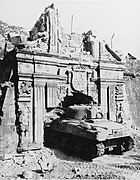 A U.S. Army M4 Sherman enters the fort during the Battle of Manila, 1945
A U.S. Army M4 Sherman enters the fort during the Battle of Manila, 1945
-
 Fort Santiago gate before its reconstruction and restoration
Fort Santiago gate before its reconstruction and restoration
-
 Fort Santiago gate after restoration
Fort Santiago gate after restoration
-
 The entrance of Fort Santiago
The entrance of Fort Santiago
-
 The grounds of Fort Santiago with the Binondo skyline in the background
The grounds of Fort Santiago with the Binondo skyline in the background
-
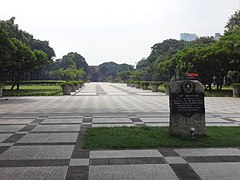 Fort Santiago in 2020
Fort Santiago in 2020
See also
References
- Robb, Walter (1939). Filipinos. Manila: Carmelo & Bauermann. pp. 210–215.
- John T. Pilot (October 22, 2009). "Fort Santiago Gate". Flickr. Retrieved on January 8, 2012.
- John T. Pilot (October 22, 2009). "Fort Santiago Gate". Flickr. Retrieved on January 8, 2012.
- ^ Congressional Serial Set. U.S. Government Printing Office. 1903. p. 437.
 This article incorporates text from this source, which is in the public domain.
This article incorporates text from this source, which is in the public domain.
- Congressional Serial Set. U.S. Government Printing Office. 1903. p. 435.
 This article incorporates text from this source, which is in the public domain.
This article incorporates text from this source, which is in the public domain.
- BLAIR, Emma Helen & ROBERTSON, James Alexander, eds. (1903). The Philippine Islands, 1493–1803. Vol. 04 of 55 (1576–1582). Historical introduction and additional notes by Edward Gaylord BOURNE. Cleveland, Ohio: Arthur H. Clark Company. ISBN 9781153716161. OCLC 769945703.
Explorations by early navigators, descriptions of the islands and their peoples, their history and records of the catholic missions, as related in contemporaneous books and manuscripts, showing the political, economic, commercial and religious conditions of those islands from their earliest relations with European nations to the beginning of the nineteenth century.
- "Fort Santiago Marker". Wikimedia Commons. Retrieved on January 7, 2012.
- ^ Congressional Serial Set. U.S. Government Printing Office. 1903. p. 436.
 This article incorporates text from this source, which is in the public domain.
This article incorporates text from this source, which is in the public domain.
- tzquita (2008-007-11). "At the gate of Fort Santiago". Flickr. Retrieved on January 17, 2012.
- https://academic.oup.com/past/article/232/1/87/1752419 Convicts or Conquistadores? Spanish Soldiers in the Seventeenth-Century Pacific By Stephanie J. Mawson] AGI, México, leg. 25, núm. 62; AGI, Filipinas, leg. 8, ramo 3, núm. 50; leg. 10, ramo 1, núm. 6; leg. 22, ramo 1, núm. 1, fos. 408 r –428 v; núm. 21; leg. 32, núm. 30; leg. 285, núm. 1, fos. 30 r –41 v .
- Robertson, J.A., and E.H. Blair. The Philippine Islands 1493-1898. Vol. Volume 4. Jeroen Hellingman and the Distributed Proofreaders Team, 2004. Print.
- "Fort Santiago, Intramuros, Manila, Philippines". Flickr. Retrieved on January 9, 2012. One of the inmates who survived the torture and the War was Roy Anthony Cutaran Bennett.
- tzquita (2008-007-11). "At the gate of Fort Santiago". Flickr. Retrieved on January 7, 2012.
- U.S. War Department (1903). "Annual Report of the War Department, 1903 Vol. III". Government Printing Office, Washington.
External links
- [REDACTED] Media related to Fort Santiago (Manila) at Wikimedia Commons
- The gate of Fort Santiago in the 1920s from Flickr
| Historic District of Manila | ||
| Buildings |  | |
| Fortifications | ||
| Parks, open spaces, and monuments | ||
| Museums | ||
| Education | ||
| Government | ||
| Destroyed | ||
| Administrators | ||
| Regulations | ||
| Visitor attractions in Metro Manila | |
|---|---|
| Historical sites | |
| Religious buildings | |
| Museums and galleries |
|
| Integrated resorts | |
| Amusement |
|
| Parks and gardens | |
| Shopping | |
| Events and traditions | |
| Event venues | |
| By type | |
| Spanish colonial fortifications in the Philippines | |
|---|---|
| Luzon |
|
| Visayas |
|
| Mindanao |
|
| Philippine Registry of Cultural Property (PRECUP) | ||
|---|---|---|
| Government cultural agencies | ||
| Categories of cultural properties | ||
| Related | ||
- Buildings and structures in Intramuros
- Forts in the Philippines
- National Shrines of the Philippines
- Spanish colonial fortifications in the Philippines
- Landmarks in the Philippines
- History of the Philippines (1565–1898)
- Spanish colonial infrastructure in the Philippines
- Cultural Properties of the Philippines in Metro Manila
- Tourist attractions in Manila
- Reportedly haunted locations in the Philippines
- Buildings and structures of the Philippines destroyed during World War II